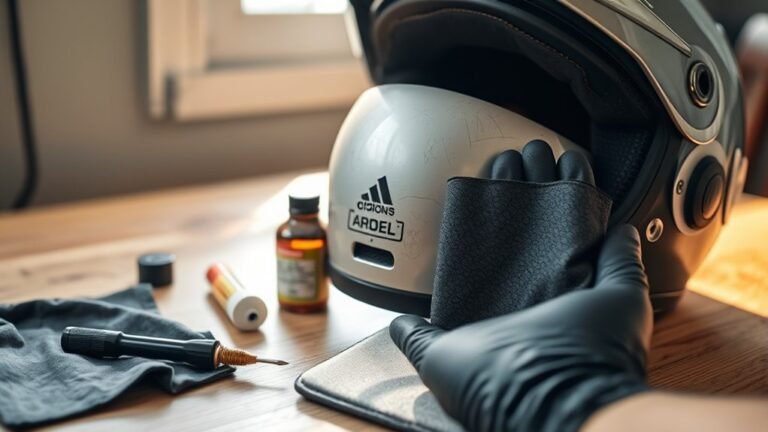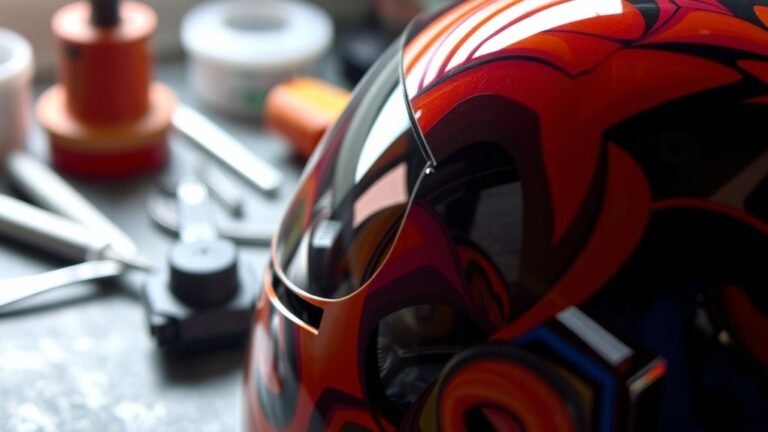Why Replace Your Helmet After a Crash?
You should replace your helmet after a crash because even minor impacts can compromise its structural integrity. Helmets are built with layers designed to absorb shock, and impacts can lead to unseen damage in the foam and outer shell. Signs like dents or unusual textures indicate potential failure. Continuing to use a damaged helmet increases your risk of head injury. Understanding replacement guidelines can help guarantee your safety on every ride—there’s more to explore on this topic.
Understanding Helmet Construction and Materials
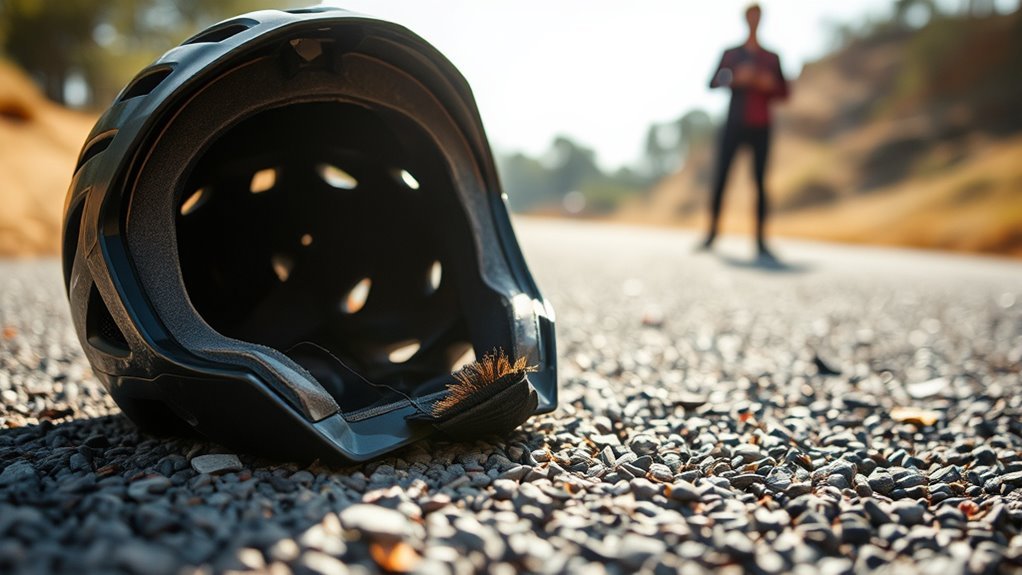
When it comes to safety gear, the helmet is a critical piece designed to protect your head during impacts. Understanding its construction is essential for ensuring your safety. Helmets typically consist of multiple layers, each serving a specific purpose. The outer layer is usually made from hard materials like polycarbonate or fiberglass, providing initial impact resistance. Beneath this, you’ll find an energy-absorbing foam layer, often crafted from expanded polystyrene (EPS), which helps dissipate forces during a crash. Some helmets even incorporate advanced materials like Kevlar for additional strength. The combination of these helmet layers and material types works together to enhance protection, giving you the freedom to ride or partake in activities with greater confidence in your safety.
The Impact of a Crash on Helmet Integrity
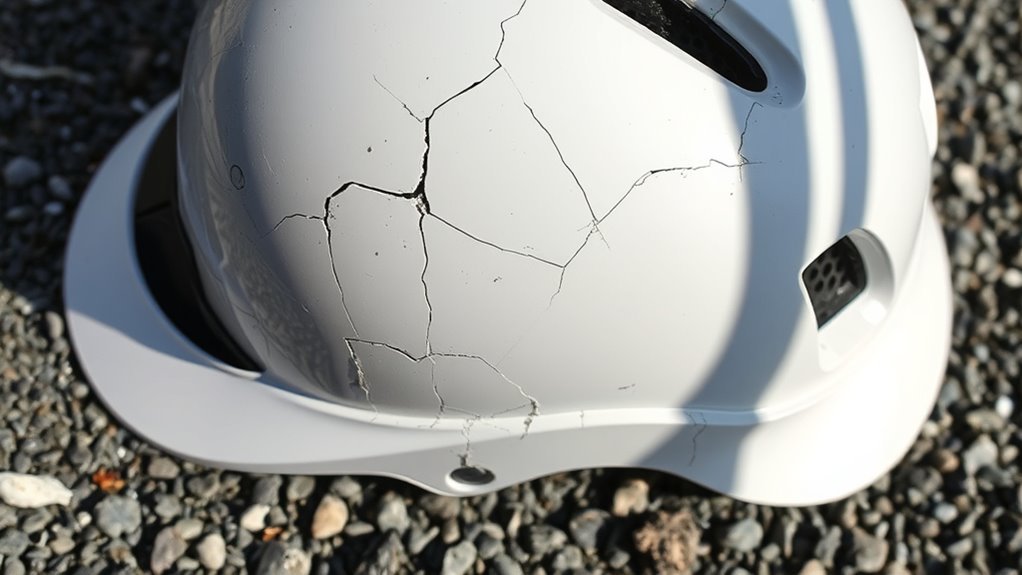
Although a helmet may appear intact after a crash, its structural integrity could be greatly compromised. The force of impact can lead to helmet deformation, which isn’t always visible to the naked eye. This deformation can affect the foam liner and outer shell, critical components that absorb shock during an accident. Even minor impacts can degrade safety performance, reducing the helmet’s ability to protect your head in future incidents. Remember, a helmet’s design is engineered to withstand only a specific level of force. Once this threshold is exceeded, its protective capabilities diminish considerably. To guarantee your safety and freedom while riding, replace your helmet after any crash, regardless of its outward appearance. Your well-being is worth the investment.
Signs of Damage to Look Out For
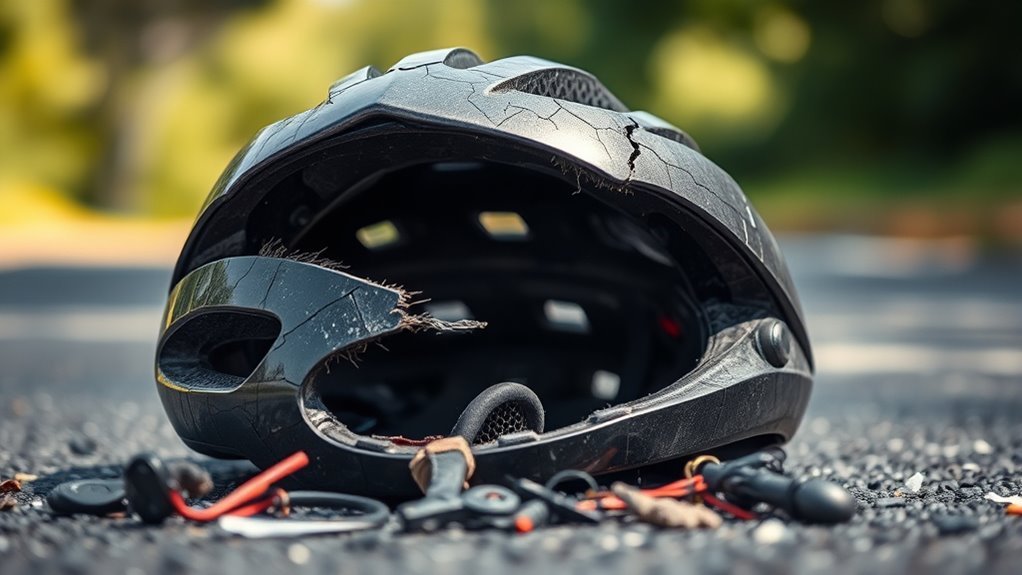
Identifying signs of damage on your helmet is essential for ensuring your safety. Start with a thorough visual inspection; look for scratches, dents, or deformities on the exterior. These surface irregularities can indicate underlying issues. Pay close attention to the foam liner; any compression or irregular texture may signal that the helmet’s protective ability is compromised. Next, check for internal cracks. Gently flex the helmet while observing for any fractures in the inner structure. If you notice any signs of damage, it’s best to retire the helmet immediately, even if it seems minor. Remember, a damaged helmet can’t provide the protection you need, so don’t take chances with your safety. Always prioritize a reliable helmet for your rides.
The Science Behind Helmet Safety Standards
Understanding helmet safety standards requires a look at impact absorption mechanisms and the rigorous testing protocols involved. These standards are designed to guarantee helmets effectively reduce the force of impacts, protecting your head during a crash. By grasping these principles, you can make informed decisions about helmet safety and replacement after an incident.
Impact Absorption Mechanisms
When a helmet sustains an impact, its ability to absorb energy is essential for protecting the wearer from potential head injuries. The design focuses on impact dynamics, utilizing materials that guarantee effective energy dispersion. This mechanism is significant; it reduces the force transmitted to your skull, minimizing injury risks.
| Energy Absorption Method | Description |
|---|---|
| Foam Layers | Compresses upon impact |
| Hard Shell | Distributes force evenly |
| Multi-Density Foam | Adapts to various impacts |
| Air Channels | Enhances ventilation |
| Flexible Materials | Allows for better fit |
Understanding these mechanisms empowers you to make informed decisions about helmet safety, ultimately preserving your freedom to ride or engage in sports with confidence.
Testing Protocols Explained
While you might trust that your helmet will keep you safe, it’s important to know how rigorous testing protocols guarantee that helmets meet safety standards. These protocols involve crash simulations that mimic real-world impacts, evaluating how well a helmet absorbs energy and protects your head. Various organizations, like the Snell Foundation and DOT, establish specific testing standards to maintain consistency and reliability in performance. During testing, helmets undergo different impact scenarios, examining factors like penetration resistance and retention system effectiveness. Understanding these protocols helps you appreciate the science behind helmet safety, making sure that your gear isn’t just a formality but a critical component of your riding experience. Replacing a helmet after a crash is crucial, as unseen damage may compromise its integrity.
The Risks of Continuing to Use a Damaged Helmet
A damaged helmet may look intact, but its protective capabilities can be severely compromised. Continuing to use it puts your helmet safety at risk, exposing you to serious crash consequences.
- The foam lining might lose its ability to absorb impacts.
- Structural integrity could be weakened, increasing the risk of failure during a crash.
- Hidden cracks may go unnoticed, leading to catastrophic outcomes.
Relying on a compromised helmet is a gamble with your safety. In the event of another accident, the helmet won’t provide the necessary protection, potentially resulting in severe head injuries. Don’t let a false sense of security cloud your judgment; prioritizing your safety means replacing a damaged helmet without hesitation. Your freedom to ride depends on it.
How Often Should You Replace Your Helmet?
When evaluating how often to replace your helmet, consider both impact damage and manufacturer recommendations. Most helmets have a lifespan of three to five years, depending on usage and conditions. Regularly reviewing these factors guarantees ideal safety and performance.
Impact Damage Assessment
Understanding how to assess impact damage is essential for determining when to replace your helmet. Conducting an effective impact assessment during a crash evaluation can safeguard your well-being. Here are key factors to take into account:
- Visible Damage: Look for cracks, dents, or deformation on the outer shell.
- Suspension Integrity: Check the internal padding and straps for any signs of wear or detachment.
- Age and Usage: Reflect on how long you’ve owned the helmet and the frequency of use, as materials can degrade over time.
If you notice any of these issues, it’s time to replace your helmet. Trusting your gear is critical for freedom on the road, and ensuring your helmet is in ideal condition is a fundamental part of that journey.
Manufacturer Recommendations
While many riders may underestimate the importance of helmet replacement, manufacturers typically recommend replacing your helmet every 3 to 5 years, regardless of visible damage. This timeframe is rooted in manufacturer guidelines, which consider the degradation of materials over time. Even if your helmet looks fine, internal components may lose effectiveness, compromising safety.
| Timeframe | Action Required |
|---|---|
| 1 Year | Check for visible damage |
| 3 Years | Replace if used frequently |
| 5 Years | Mandatory replacement |
| After a Crash | Immediate replacement |
| New Models | Consider for updated safety certifications |
Adhering to these recommendations guarantees your helmet provides maximum protection, allowing you the freedom you seek while riding.
Lifespan Considerations
Replacing your helmet isn’t just about adhering to manufacturer guidelines; it’s also about recognizing the factors that influence a helmet’s lifespan. Understanding these factors can guarantee peak helmet durability and crash performance.
- Material degradation: Over time, the materials can weaken, compromising protection.
- Environmental exposure: UV rays, extreme temperatures, and moisture can wear down a helmet’s integrity.
- Usage frequency: Regular impacts or even daily wear can reduce your helmet’s effectiveness.
Generally, it’s wise to replace your helmet every 3-5 years, even without a crash. If you’ve experienced a fall, replacing it immediately is essential. Remember, your safety is paramount, and a reliable helmet can make all the difference in a critical moment. Stay free and ride smart!
Choosing the Right Replacement Helmet
When selecting a replacement helmet after a crash, it’s crucial to evaluate various factors that influence safety and fit. Start by understanding the replacement criteria, which include safety certifications, materials, and design. Look for helmets that meet or exceed industry standards, such as DOT or Snell certifications. Next, focus on helmet fit; it should feel snug without discomfort. Try on multiple sizes and styles, as each brand may differ in shape. Don’t forget to take into account the type of riding you do—different disciplines may require specific features. Finally, contemplate additional safety technologies, like MIPS, which can enhance impact protection. Choosing wisely guarantees you’re not only safe but also free to ride confidently.
Frequently Asked Questions
Can I Repair My Helmet After a Crash?
You can’t really repair your helmet after a crash. Have you ever considered how essential helmet integrity is for your safety? While some might suggest repair techniques, they often compromise the protective qualities designed to save your life. Even minor damage can undermine the helmet’s ability to absorb impact. Investing in a new helmet guarantees you’ve got reliable protection, allowing you to enjoy your freedom without the worry of inadequate headgear.
How Do I Properly Dispose of a Damaged Helmet?
To properly dispose of a damaged helmet, check for recycling options in your area; many local programs accept helmets for materials recovery. If recycling isn’t available, follow disposal guidelines by removing any straps and padding, then placing the shell in your regular trash. Make certain it’s not usable to prevent someone from accidentally wearing it. Always prioritize safety and responsible disposal to maintain freedom on the road.
Are There Specific Brands Known for Better Safety Ratings?
When it comes to safety, think of your helmet as your trusty shield. Brands like Bell, Shoei, and Arai consistently score high in safety certifications, proving their worth in brand comparisons. Look for helmets that meet DOT or Snell standards, as these indicate rigorous testing. It’s essential to prioritize protection without sacrificing comfort, so always try on different models to find the one that feels just right, allowing you the freedom to ride with confidence.
What Should I Do With My Helmet if It’s Still New?
If your helmet’s still new, make sure it meets current safety standards and consider its lifespan, typically around five years. Store it in a cool, dry place away from direct sunlight to prevent degradation. Regularly inspect it for any signs of damage or wear. If you plan to use it for extreme activities, keep a close eye on its condition, as helmets can deteriorate over time even without visible damage. Prioritize your safety!
Does the Type of Crash Affect Helmet Replacement Needs?
Yes, the type of crash considerably affects your helmet replacement needs. In a high-severity crash, the impact absorption capabilities of your helmet may be compromised, leading to potential safety risks. Even minor crashes can cause unseen damage. If you experience any notable impact, it’s essential to replace your helmet immediately. Your safety and freedom depend on having reliable protection, so don’t take chances with a compromised helmet. Prioritize your well-being on every ride.

